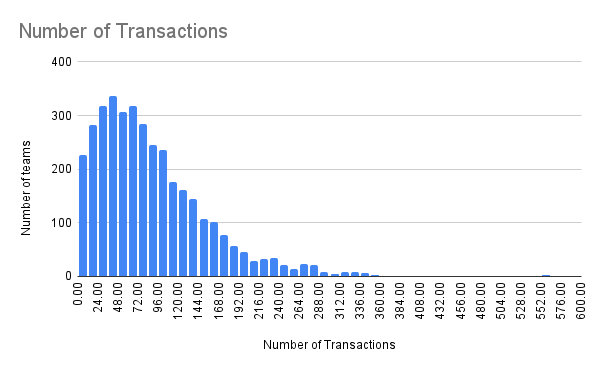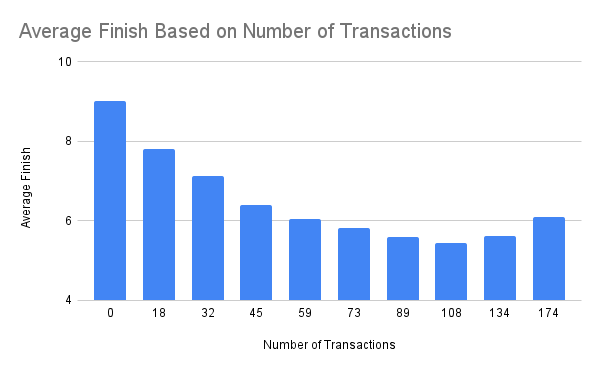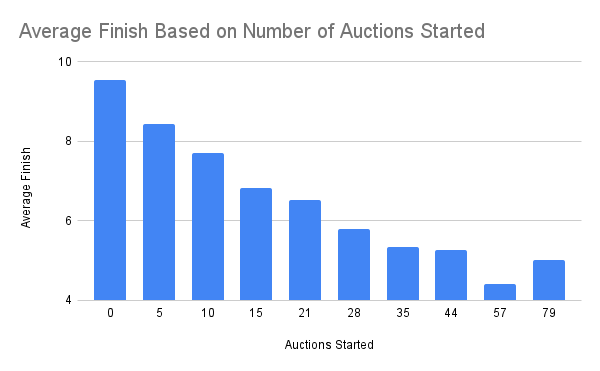The Value of Activity in Ottoneu Leagues
I commonly hear people praising active managers in fantasy leagues, and there is good reason for this. Active managers make for a fun league. My favorite leagues are the ones with regular transactions, trades, etc., where every manager is engaged. While activity makes for a fun league, the praise for active managers often assumes active managers are “good” or “winning” managers. Fun is hard to measure, but good we can try to validate.
Ottoneu creator Niv Shah shared data with me on the 2023 season that included every team in an OPL-eligible league, how many transactions they completed during the season (starting from Opening Day), how much cap they had tied up in cap penalties at the end of the season, how many auctions they participated in, and their final place in their league standings. I dug in to see if the more active teams were the better teams and to try to figure out how active is active enough.
Before diving into how these activities relate to winning, let me share some basic summary data:
| Metric | Median | Average |
|---|---|---|
| $ in Cap Penalties | 29 | 33.6 |
| Total Transactions | 73 | 87.6 |
| Add/Cut Transactions | 63 | 76.5 |
| Players Traded | 7 | 11.1 |
| Auctions Started | 27 | 36.4 |
| Auction Bids Placed | 53 | 64.2 |
A few notes and definitions:
- There are 304 leagues of 12 teams each in this dataset.
- Cap penalties is as of the end of the season.
- Add/Cut transactions are all discrete player adds or cuts. If you win an auction for a hot prospect and cut another player to make room, that is two transactions.
- Players Traded is total players involved in trades, not total trades made. A 2-for-2 trade is four player transactions.
- Auction bids placed includes any auction a team started in which they also actively placed a bid. A passively placed bid (e.g., starting an auction without going to the auction page and entering a number for your bid) counts as an auction started but NOT as a bid placed.
- Note that the averages are all higher than the medians. There are a handful of outlier teams that are pulling up the averages quite a bit.

While this graph goes up to nearly 600 (congrats to the team Joseph Daniel Vottoneu on a) having a great team name, b) winning your league, and c) leading the entire Ottoneu universe with 561 transactions in 2023), only 6.6% of teams had over 200 transactions and only about a third had over 100. This pattern holds true for the other metrics, as well.
Now let’s look at some correlations between those metrics and winning.
| Metric | Correlation to Final Place in Standings |
|---|---|
| Auction Bids Placed | -0.358 |
| Auctions Started | -0.329 |
| Add/Cut Transactions | -0.199 |
| Total Transactions | -0.192 |
| Players Traded | -0.068 |
| $ in Cap Penalties | -0.043 |
The first obvious note here is that all correlations are negative because a lower place in the standings is better (you’d rather be 1 or 2 than 11 or 12). So right off the bat we get something that makes sense – the more a team did, the better they finished.
The second, also obvious note, is that none of these numbers are crazy high. Being active does not mean you will win. More active teams do win, but 43 teams won without making a single trade. 42 teams won with less than 50 total player transactions over the season (roughly one add and one cut per week). Two teams won with less than 20 transactions (congrats to Narco Hunting We Will Go for being the least active champ, winning their league with just 16 transactions all season). You can’t do NOTHING and expect to win (21 teams had 0 transactions and their average finish was 10.7) but you can certainly win with a strong team and a laid-back approach to free agency and trades.
But let’s look at these in pairs.
The highest correlation between winning and activity is for starting and bidding in auctions. Given there is no inherent advantage to starting auctions (and that starting and bidding are highly correlated to each other (0.86), I assume that this is proxying for something else. There are three things I think are likely candidates:
- Some of this is overlaps with the Add/Cut transactions. There is value in replacing underperforming or unneeded players with players who can help, and you have to either make a trade or place (and win) a bid to do that.
- Managers who are active in starting and bidding on auctions are also just visiting the league page more often, and likely making daily lineup adjustments, etc. I don’t have the data on daily lineup moves, but I suspect that correlates highly with winning and we are seeing some of that effect here.
- Starting on and bidding in auctions is likely related, at least at some level, to generally being an informed manager. There are other impacts here (time, number of leagues you play in, etc.) that are not measures of knowledge, but a manager who is starting a lot of auctions is doing something to find those names and make those moves.
The next bucket is adds and cuts. Total Transactions is simply a combination of Trades and Add/Cut Transactions, and there are far more of the latter (see the summary data above), so these two lines are effectively measuring the same thing. Actively making upgrades via the wire helps, but doesn’t do everything.
Finally, number of players traded and cap penalties made almost no impact on final standings. For number of trades, this is a little misleading, as there is a relationship between standings and trades, it just isn’t linear. Second-place teams made the most trades, on average, at 15.0, followed by first-place teams (14.9) and then last-place teams (12.4). I am using average here instead of median because some last-place teams were totally disengaged and did nothing, skewing the data. If you are in an active league, there is a good chance the most active traders are those at the very top or very bottom. The teams in the middle are less likely to sell (“Maybe I can climb back into this or qualify for OPL at least!”) or buy (“I don’t really want to give up my top prospect for a low probably shot at winning!”).
Cap penalties also makes sense because the top teams are more likely to be active, making more cuts, but also more likely to have cut decent players that other teams want.
So we have some data here that suggests being active is better, so you should, of course, be as active as humanly possible at all times, right?
Not exactly. There are two issues with that line of thinking. One is just a reminder that when the metric becomes the goal, it ceases to be a good metric. Your goal is to win. Being active can help you win if you are active in the right ways. But if being active becomes the goal, that’s not good.
Second, there are diminishing returns on activity.

That chart is based on deciles of transactions – I broke the dataset into buckets that each represented about 10% of total teams. The teams in the most active bucket made 174+ transactions each; the second bucket made 134+, then 107+ and so on down to the least active bucket. Teams in that bucket made between 0 and 17 transactions.
The first five deciles show pretty clear gains when teams are more active, from finishing bottom four to nearly the top half. Deciles 5-8 continue to show gains, but once you get into the top 20% of most active teams, you very well may be hurting yourself by being too active.
Why would being too active hurt? One possibility is that being too active isn’t hurting teams, but that underperformance causes teams to be more active. Once you realize your team isn’t good, you are more aggressive making moves and turning over the roster to improve. If that were the case, we might see a pattern like we do with traded players where last-place teams make more trades than teams in the middle, but we don’t see that. The least active teams are, on average, the 11th-place teams, with 12th-place teams almost even. This is true whether you look at median or mean transactions.
Another possibility is that those teams are reactive rather than proactive. The high number of moves may suggest they are just bidding in every auction they see, possibly implying the moves are less thought out and more haphazard. There is a similar pattern if we look at deciles of activity based on auctions started rather than transactions, but the drop off in finish comes later.

So this does suggest that being super active starting auctions is better than just being active winning auctions, but you still see diminishing returns when you get above the 50th percentile and a drop off in the finishing spot of the most active decile vs. the next most active. Starting the most auctions is no more effective than being barely above the median (and it requires a lot more effort) and it is worse than dialing it back just a bit.
Which brings me to the third reason being too active might be a detriment to your chances of winning: at some point, you are churning good players instead of making actual upgrades and there is just no value in that. In fact, when you are moving too aggressively you are, at some point, going to bail on a good decision too quickly.
There is a lot going on in this article, but I am taking away four things:
- Being active is good, but the majority of managers are already plenty active. 20-30% of managers probably should get more active; everyone else might benefit a bit by being more active but it isn’t necessary and it might actually hurt.
- Being active appears to be good, but good is not the same as necessary. There was at least one league champ in each of the transactions deciles. You can win making very few moves during the season. If you don’t want to be a highly active manager, you don’t have to be and you can still win a title.
- If you are one of the most active managers, you might want to dial things back. I also want to note that all of this was an analysis of what can help you win your league, not what will help you enjoy your league. If making four transactions a day is how you enjoy fantasy baseball, go for it. Just remember that at some point those extra moves are fun but not productive.
- I am going to try to put myself in a position to start more auctions. I want to be clear that I am not just going to start more auctions, but I am going to try to be more aware of the free agent market in my leagues and more proactive about identifying players I might want to pick up. I don’t believe the act of starting auctions directly helps teams win, but I do believe the same research and activities that lead to starting more auctions will make me a better manager.
A long-time fantasy baseball veteran and one of the creators of ottoneu, Chad Young's writes for RotoGraphs and PitcherList, and can be heard on the ottobot podcast. You can follow him on Twitter @chadyoung.
Looks like the second half of this article is stuck as a caption to the “Correlation Between Activity and Winning” table